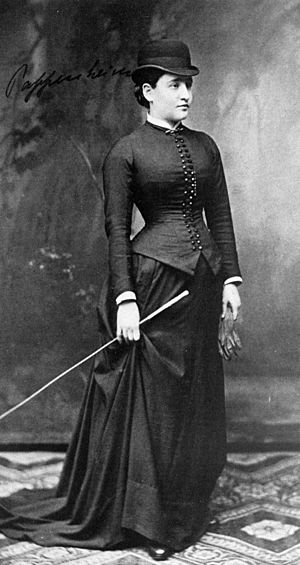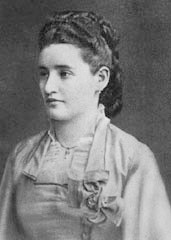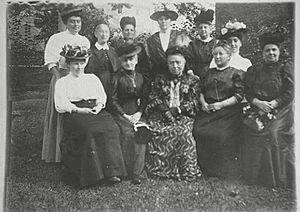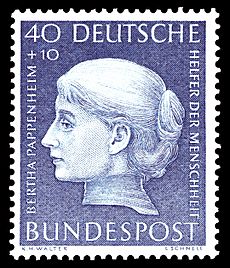Bertha Pappenheim facts for kids
Quick facts for kids
Bertha Pappenheim
|
|
|---|---|

Pappenheim in 1882
|
|
| Born | 27 February 1859 |
| Died | 28 May 1936 (aged 77) Neu-Isenburg, Nazi Germany
|
| Nationality | German, of Austrian descent |
| Other names | Anna O., "Only a Girl", Paul Berthold |
| Occupation | Social Worker and President of the Jüdischer Frauenbund |
| Known for | Jüdischer Frauenbund, early case of Josef Breuer |
Bertha Pappenheim (born February 27, 1859 – died May 28, 1936) was an Austrian-Jewish feminist. She was a pioneer in social work. She also founded the Jewish Women's Association (known as 'Jüdischer Frauenbund'). She was known as "Anna O." when she was a patient of Dr. Josef Breuer. Her case became very important in the early history of psychoanalysis.
Contents
Early Life and Family
Bertha Pappenheim was born in Vienna on February 27, 1859. She was the third daughter of Recha and Sigmund Pappenheim. Her mother, Recha Goldschmidt (1830–1905), came from a rich family in Frankfurt am Main, Germany. Her father, Sigmund (1824–1881), was a merchant from Bratislava, Slovakia. He was a co-founder of a Jewish school in Vienna.
Bertha grew up in a very traditional Jewish home. She felt that her parents would have preferred a boy. She went to a Roman Catholic girls' school. Her life followed the Jewish holiday calendar. She spent summers in Ischl.
When Bertha was eight, her oldest sister, Henriette, died from a serious illness. At age 11, her family moved to a different part of Vienna. She left school at 16. She spent her time doing needlework and helping her mother prepare kosher food. Her younger brother, Wilhelm, went to high school, which made Bertha feel jealous.
Her Illness and Treatment
Between 1880 and 1882, Bertha had many health problems. These began when her father became very sick in 1880. While caring for him at night, she started having strange visions and feeling very anxious.
In November 1880, a family friend, Dr. Josef Breuer, began treating her. He encouraged her to tell stories, sometimes while she was lightly hypnotized. This helped some of her symptoms, but her overall health got worse. Dr. Breuer shared her case with his friend, Sigmund Freud. This helped Freud understand early ideas about a condition called "hysteria."
Bertha was very sick and stayed in bed for months starting in December. Her father died in April 1881. After this, she became very stiff and stopped eating for days. Her symptoms worsened, and she was admitted to a sanatorium (a special hospital) in June. She stayed there until November. She returned to this sanatorium several times later.
Dr. Breuer said that Bertha slowly got better by remembering and talking about her symptoms. He wrote that she fully recovered in June 1882.
Dr. Breuer gave Bertha the fake name "Anna O." in his notes. He changed her initials, B.P., to A.O. to protect her privacy. Parts of Anna O.'s story were first shared in medical journals in 1893. A detailed report appeared in 1895 in a book called Studies on Hysteria, which Dr. Breuer wrote with Freud.
Symptoms She Experienced
Bertha had many symptoms. These included a bad cough, paralysis on the right side of her body, and problems with her sight, hearing, and speech. She also had visions and lost awareness sometimes. Doctors called her condition "hysteria." Freud thought her illness came from strong feelings about her father's sickness and death.
Over two years, she had many different symptoms:
- Speech problems: Sometimes she could not speak at all. Other times, she could only speak English, French, or Italian. She always understood German. These periods of not speaking could last for days.
- Pain: She had severe pain in her face.
- Paralysis: Her arms and legs sometimes felt weak or numb, mostly on one side. She was right-handed but had to learn to write with her left hand.
- Vision problems: Her eyes sometimes moved strangely. Objects looked much bigger to her, and she squinted.
- Mood changes: She often switched between feeling anxious or sad and feeling relaxed.
- Memory loss: When she was in one state of mind, she could not remember what happened in the other state.
- Eating problems: During difficult times, she refused to eat. Once, she did not drink liquids for weeks, only eating fruit.
- Imagined symptoms of pregnancy: There are some reports that she showed signs of a false pregnancy during her last meeting with Dr. Breuer.
Many people now think her illness might have been a physical problem with her brain, not just a mental one. Some suggest she had tuberculous meningitis (a brain infection) or encephalitis (brain inflammation). Others think she had a type of temporal lobe epilepsy, because some of her symptoms, like imagined smells, are common with epilepsy.
How Dr. Breuer Treated Her
Dr. Breuer started treating Bertha without a clear plan. He would feed her if she refused to eat. He also gave her medicine when she was upset.
He noticed that she had two different states of mind. They would switch often and suddenly. In one state, she was sad but mostly normal. In the other, she had visions and acted out, like throwing pillows.
He saw that in one state, she could not remember what happened in the other. He felt like she had "two personalities." Today, this is sometimes called dissociative identity disorder.
Dr. Breuer found that Bertha calmed down and spoke better when she told stories from her daydreams. He encouraged her to "reel off" these stories. She often started with, "There was a boy…" Sometimes she could only speak English, but she understood German. Dr. Breuer said her stories were often sad but beautiful.
Bertha felt relief from telling her stories. She called this process "chimney-sweeping" and the "talking cure." The term "talking cure" later became famous in psychology.
Dr. Breuer developed a method where Bertha would remember and tell the stories of when her symptoms first appeared. He was surprised to see that a symptom would disappear after she remembered its first occurrence.
He would ask her in the morning, sometimes under light hypnosis, about her symptoms. In the evening, she would tell him about these events in reverse order. When she reached the very first time a symptom appeared, it would get stronger and then disappear "forever."
Dr. Breuer spent about 1,000 hours treating Bertha over two years.
The End of Her Treatment
One story says her therapy ended when she recalled a vision of a black snake. This vision happened one night when she was at her father's sickbed. Dr. Breuer wrote that all her "hysteria" ended then. She decided to finish the "talking cure" on a special anniversary. She recreated her father's sickroom and remembered the first vision. After that, she spoke German again and was free of her symptoms.
Another story, told by Freud, suggests a different ending. It says that on the last night, Dr. Breuer was called back to Bertha's home. She was having stomach pains and imagined she was having his child. Freud said Dr. Breuer was shocked and quickly handed her care to another doctor. He then went on a trip. This story is mostly believed to be untrue. Records show Dr. Breuer referred her to another clinic and went on a family vacation, not a "second honeymoon." His youngest child was born before this supposed event.
Freud's reasons for telling this different story are not fully clear. He always gave Dr. Breuer credit for his role in the "talking cure."
How Successful Was the Treatment?
Despite what Dr. Breuer and Freud first reported, historical records show that Bertha was not fully better when Dr. Breuer stopped treating her. She was still very ill and was sent to a special hospital. Dr. Breuer even told Freud he hoped she would die to end her suffering.
Later, some of Freud's students questioned if the treatment was truly successful. Carl Gustav Jung said in 1925 that the famous first case was "nothing of the sort." He said Freud told him that all her old symptoms came back.
However, others say Bertha made a great recovery. They believe the talking therapy helped her get rid of her symptoms.
Bertha herself never spoke about this time in her life. She was strongly against using psychoanalytic treatment for people she cared for later in life. It is thought she destroyed many documents about her illness in 1935.
Bellevue Sanatorium
On July 12, 1882, Dr. Breuer sent Bertha to the Bellevue Clinic in Kreuzlingen, Switzerland. She was no longer treated by Dr. Breuer after this.
While at Bellevue, she visited her cousins in Karlsruhe, Germany. Her cousin, Anna Ettlinger, was a founder of a girls' high school. Anna encouraged Bertha to continue her writing. Bertha also took a nursing course there.
Her condition improved, and she was released from Bellevue in October 1882. After some small setbacks, Bertha became a very respected woman in Germany and among European Jews.
Public Life and Activism
In November 1888, at age 29, Bertha and her mother moved to Frankfurt, Germany. There, they became involved in art, science, and charity work.
Bertha first worked in a soup kitchen and read to girls at a Jewish orphanage. She loved seeing the children enjoy stories. This led her to write more and get involved in social and political work. She started publishing her writings in 1888, first anonymously, then under the name Paul Berthold, and finally under her own name in 1902.
In 1896, she became the official director of the orphanage. For 12 years, she changed the school's focus. Instead of just preparing girls for marriage, she trained them for jobs and independence.
Bertha saw how Catholic and Protestant charities helped women who were forced into slavery. She wanted to find a Jewish charity with a similar goal. Her cousin told her no such group existed, and that Jewish people did not want to talk about this problem. Bertha also spoke out about Jewish men who could leave their wives and children without a divorce. This left women unable to remarry and their children without support.
Becoming an Activist
In 1895, Bertha joined a meeting of the General German Women's Association in Frankfurt. She later helped start a local group for this association.
In 1901, Bertha gave a speech that led to the creation of a women's group. This group aimed to organize and improve social work projects. In 1904, it became its own organization called 'Weibliche Fürsorge' (Women's Relief).
In 1902, Bertha and another woman, Sara Rabinowitsch, traveled to Galicia. They went to study the social problems there, especially about women being trafficked. Bertha wrote a report in 1904 describing the issues.
In 1904, a meeting in Berlin decided to create a national Jewish women's association. Bertha was chosen as the first president of the 'Jüdischer Frauenbund' (JFB). She led it for 20 years and worked with them until her death in 1936. The JFB joined a larger German women's association in 1907. Bertha was also on the board of that larger group from 1914 to 1924.
The JFB had two main goals. One was to strengthen women's rights and help Jewish women find jobs. The other was to continue traditional Jewish charity work. The JFB grew quickly, reaching over 50,000 members at one point. In 1917, Bertha called for Jewish welfare work to be more organized. This led to the creation of the Central Welfare Agency of German Jewry, which still exists today.
In May 1923, Bertha was a main speaker at the First World Congress of Jewish Women in Vienna. She talked about the need to protect Jewish girls and women from being trafficked.
After the Nazis came to power in 1933, Bertha again became president of the JFB. She resigned in 1934 because she disagreed with the growing support for Zionism (a movement to create a Jewish homeland) among German Jews. She did not want children to move to Israel if their parents stayed in Germany. However, in 1934, she did help a group of orphanage children move safely to Great Britain. After the anti-Jewish Nuremberg Laws were passed in 1935, she changed her mind and supported Jewish people leaving Germany.
Bertha Pappenheim died in 1936. The Nazis disbanded the JFB in 1939.
Neu-Isenburg Home
Bertha started many important places, like kindergartens and educational centers. She considered her most important work to be the Neu-Isenburg home for Jewish girls.
Around 1906, Bertha focused on creating a safe place for unmarried girls and Jewish women at risk of being trafficked. She wanted this home to follow new ideas for social work:
- It would focus on education and training for independent life, not just traditional charity.
- It would follow up with former residents to make sure they stayed safe and successful.
- It would feel like a real home, not a cold institution.
- Residents would learn about Jewish traditions and culture.
- The home would be simple, teaching residents how to live in a normal, middle-class household.
A relative of Bertha's mother, Louise Goldschmidt, provided two houses for the home in Neu-Isenburg, near Frankfurt. This location was good because of its clinics and social services.
Thanks to donations, the home opened on November 25, 1907. Its goal was to provide "protection for those needing protection and education for those needing education."
The home was simple. It did not have running water in bathrooms until 1920. But it allowed for strict Jewish dietary rules (kosher). It even had a special kitchen for Passover.
Art and nature were used to educate the residents. There was a children's fountain showing a story Bertha wrote. There were also lectures and small plays. Important thinkers like Martin Buber visited and spoke there.
The number of residents grew from 10 in 1908 to 152 in 1928. The home expanded with more buildings, including one for pregnant women.
Children living at the home went to the local elementary school. They received good medical care and regular mental health checks. Bertha did not allow psychoanalytic treatment for the residents. She once said that psychoanalysis was like a tool that could be good or bad depending on how it was used.
To keep the home running, an association was formed. Members paid small fees to help cover costs.
At first, some Orthodox Jewish groups did not like the home. They thought it supported bad behavior by helping unmarried mothers. But the home worked to help these mothers and their children reconnect with their families and community.
After Bertha died in 1936, the home continued until the 1936 Olympic Games. In 1937, Jewish children were no longer allowed to attend the local school. In 1938, the local NSDAP group forced the home to close.
On November 10, 1938, after the 'Reichskristallnacht' (a night of Nazi attacks on Jews), the home was attacked. The main building was burned down, and others were destroyed. On March 31, 1942, the home was officially closed by the Gestapo. The remaining residents were sent to a concentration camp, where many died.
Her Literary Works
Stories, Plays, and Poems
Bertha first published her writings without her name, then as Paul Berthold. Many women writers used fake names back then. She started using her own name in 1902.
Her first book, 'Kleine Geschichten für Kinder' (Little Stories for Children), came out in 1888. In 1890, she published 'In der Trödelbude' (In the Junk Shop), a collection of nine stories about broken or useless items.
In 1913, she published a play called 'Tragische Momente. Drei Lebensbilder' (Tragic Moments. Three Scenes from Life). She also wrote many texts that were not published during her lifetime. Many of these are now lost. Some are short sayings called Denkzettel ("Memoranda"). One example is: "Whoever gives up his freedom without an urgent need does not deserve it." She also wrote personal poems to God, which were published after her death.
Here is a poem Bertha wrote around 1910–1912:
Love did not come to me -
So I vegetate like a plant,
In a cellar, without light.
Love did not come to me -
So I resound like a violin,
Whose bow has been broken.
Love did not come to me -
So I immerse myself in work,
Living myself sore from duty.
Love did not come to me -
So I gladly think of death,
As a friendly face.
Translations
One of her first translations was A Vindication of the Rights of Woman by Mary Wollstonecraft. This important book about women's rights was published in 1899.
Starting in 1910, Bertha translated several Yiddish texts into German:
- The memories of Glikl bas Judah Leib (also known as Glückel of Hameln), one of Bertha's ancestors (1910).
- The Ma'assebuch, a collection of stories from Jewish texts (1929).
- Parts of Ze'enah u-Re'enah, also known as the "Women's Bible."
Bertha only translated texts written by or for women. The Ma'assebuch and the Women's Bible were very popular Yiddish books for women. She explained her reasons for translating them. For Glikl's memories, she wanted to show a woman who was smart, true to her faith, and true to herself. For the Ma'assebuch, she hoped it would help people understand traditional Jewish culture better.
Bertha found out she was distantly related to Glikl while researching her family tree. She even had a portrait painted of herself as Glikl.
Articles and Information
Most of Bertha's writings aimed to share information. She wrote about the social problems of Jewish refugees and the trafficking of women. In 1924, she published her most famous book, Sisyphus-Arbeit (Sisyphean Labor). This book was a study on the trafficking of women in Eastern Europe and the Middle East.
Her Personal Life
Bertha was influenced by strong women like Glückel of Hameln, Mary Wollstonecraft, and Helene Lange. Dr. Breuer described her as a very intelligent woman with sharp thinking.
After her mother died in 1905, Bertha lived alone for many years. She wrote in a poem from 1911, "Mir ward die Liebe nicht" ('love did not come to me').
In 1924, she became close friends with Hannah Karminski, who was 40 years younger. They spent a lot of time together. When Hannah moved to Berlin in 1925, they wrote to each other almost every day.
In 1935, while traveling in Austria, Bertha donated some of her collections to a museum in Vienna. Her health got worse, and she was taken to a hospital in Munich. Doctors found a serious illness. Despite being sick, she traveled to Amsterdam and Galicia to advise schools. After returning to Frankfurt, her condition worsened, and she became bedridden. She also had jaundice.
In her last days, she was called for questioning by the police. An employee of her home had reported a girl with a disability for saying something negative about Adolf Hitler. Bertha refused to go to the hearing because she was too sick. After she provided information calmly but firmly, the police took no further action.
Bertha Pappenheim died on May 28, 1936. Her friend Hannah Karminski cared for her until the end. She was buried next to her mother in the Jewish cemetery in Frankfurt.
After Bertha's death, Hannah Karminski took over many of her roles in the JFB. Sadly, Hannah was sent to a concentration camp in 1942, where she died in 1943.
Her Legacy
In 1953, when a book about Freud identified Anna O. as Bertha Pappenheim, her friends were shocked. They knew her only as a kind social worker. A biography was written to show Bertha as a great helper of people and a women's rights activist, not just as someone who was "mentally ill."
Since Bertha did not talk about her illness, most details come from Dr. Breuer and Freud's records. New information was found later in the archives of the Bellevue Clinic.
In 1954, Germany issued a postage stamp with Bertha Pappenheim's picture. This was to honor her contributions to society. In 1997, a memorial to Bertha was opened at the former site of her Neu-Isenburg home.
Bertha Pappenheim's story, especially her time as Dr. Breuer's patient, has been shown in films like Freud: The Secret Passion and books like When Nietzsche Wept.
Impact on Psychoanalysis
Her treatment is seen as the beginning of psychoanalysis. The idea of free association started when Bertha decided to stop hypnosis and just talk to Dr. Breuer. She would say anything that came to her mind. She called this method "chimney sweeping" and the "talking cure." This became the foundation for free association.
Her case, under the name Anna O., was described in the book Studies on Hysteria ('Studien über Hysterie') in 1895. This book was published by Dr. Breuer and Freud.
|
See also
 In Spanish: Bertha Pappenheim para niños
In Spanish: Bertha Pappenheim para niños





